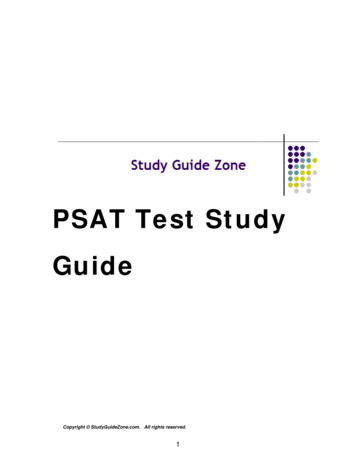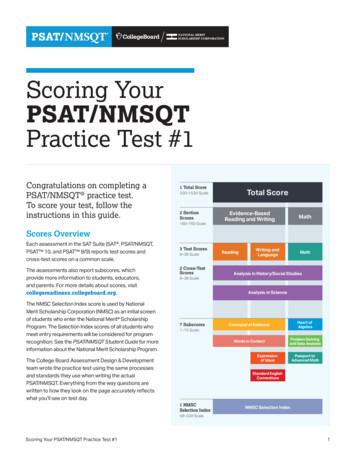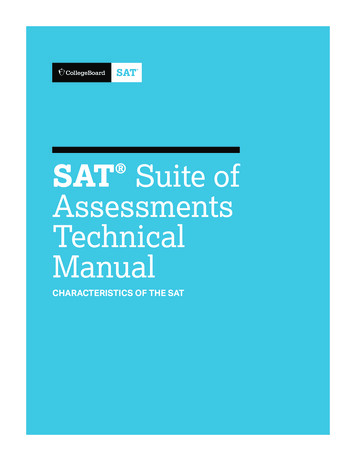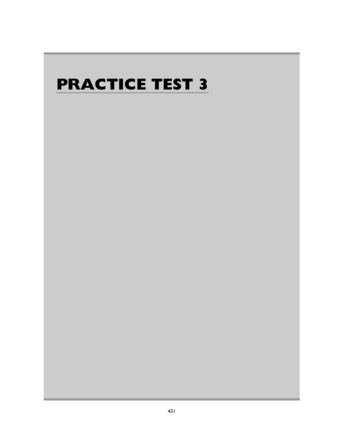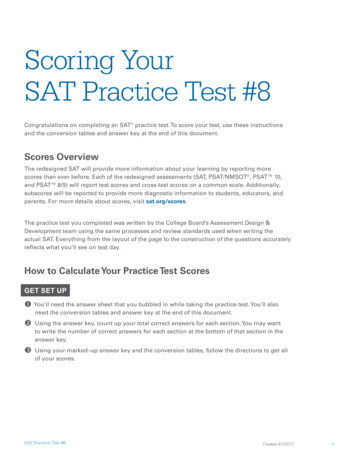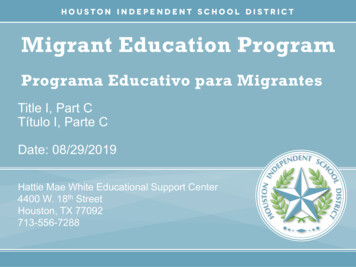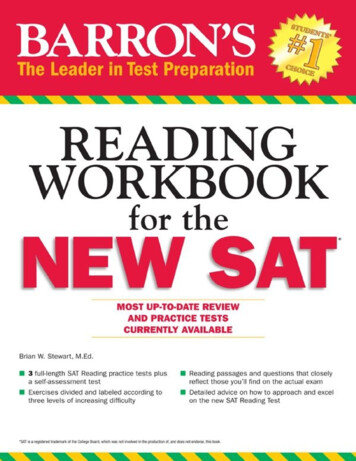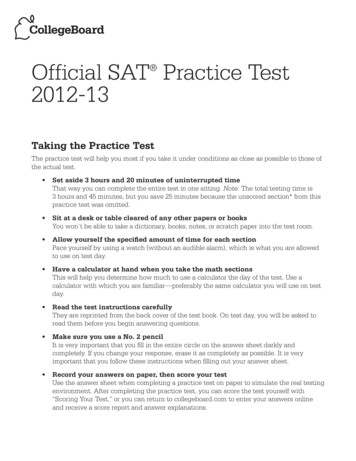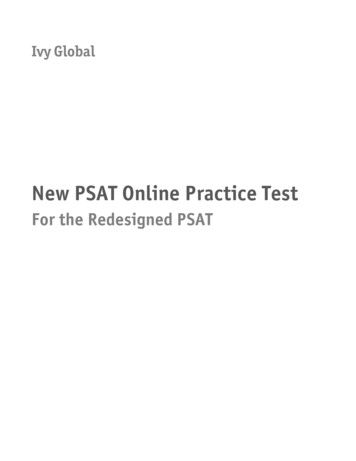
Transcription
Ivy GlobalNew PSAT Online Practice TestFor the Redesigned PSAT
NEW PSAT ONLINE PRACTICE TESTThis publication was written and edited by the team at Ivy Global.Editor-in-Chief: Sarah PikeProducers: Lloyd Min and Junho SuhEditors: Sacha Azor, Corwin Henville, Nathan Létourneau, and Kristin RoseContributors: Stephanie Bucklin, Alexandra Candib, Natalia Cole, Laurel Durning-Hammond, Lei Huang, Somin Lee, MarkMendola, and Adam WolskyThis product was developed by Ivy Global, a pioneering education company that delivers a wide range of educational services.E-mail: publishing@ivyglobal.comWebsite: http://www.ivyglobal.comPSAT is a registered trademark of the College Board, which is not affiliated with this publication.
Chapter 1Introduction
HOW TO USE THIS PDFPART 1Welcome, students and parents! This free PDF is intended to help students prepare for the PSAT, a test administered bythe College Board. It contains an overview of the PSAT, a few basic test-taking tips, a full-length practice test, an answerkey, and scoring directions.The first key to succeeding on the PSAT is to know the test. This PDF will help you know what to expect and build yourconfidence. Reading the quick tips in this PDF can help you to avoid common mistakes. Taking this practice test willhelp you to become more familiar with the format, pacing, and content of the exam. Reviewing your scores, as well asany questions you missed, can help you determine what you might need to continue studying in order to do your best ontest day.This PDF is not a totally comprehensive test-prep book. For more information about the PSAT, we recommend IvyGlobal’s New PSAT 3 Practice Tests.THE TESTThe PSAT is a standardized test written and administered by the College Board, and cosponsored by the National MeritScholarship Corporation. It is designed to assess students’ skills in critical reading, mathematics, and writing.Beginning in the fall of 2015, there will be three PSAT tests: the PSAT 8/9, the PSAT 10, and the PSAT/NMSQT(PSAT/National Merit Scholarship Qualifying Test). These tests will be taken by students in eighth or ninth grade, tenthgrade, and tenth or eleventh grade, respectively. The test in this PDF is particularly geared towards preparation for thePSAT/NMSQT, and when we say “PSAT” that’s the test we mean. However, the advice we give applies to all three tests.The PSAT is a timed exam. You will be allowed a limited amount of time for each section. Set aside a total of 2 hoursand 45 minutes for this exam. The amount of time that you will have for each section is given on the first page of eachsection. If you are taking a proctored exam, your proctor will also announce the time that you are allowed for each section.Detailed directions are provided at the beginning of each section. Read these directions carefully when taking practiceexams. You should try to be totally familiar with the directions for each section by the time that you take the real PSAT.Ivy Global3
QUICK TIPSRead every question and answer option carefully. Many students select incorrect answers simply because they misreadthe questions or don’t look at all of the answer options. Read carefully to avoid careless errors.Use the process of elimination. Sometimes the easiest way to find the correct answer is to cross out the answers in yourtest booklet that you can be sure are incorrect. Don’t cross answers out on your answer sheet as stray marks could becounted as incorrect answers.Make your best guess on every problem. You should always try to find the correct answer, but if you find that you’restumped then you should try to make your best guess. There’s no penalty for guessing.Don’t be afraid to write in your test booklet. Though you won’t receive extra credit for showing your work, writing inyour test booklet can help you work through questions and have a reference for later. You will only receive points forwhat you have marked on your answer sheet, so remember to mark something for every question.Learn more about Ivy Global products at:sat.ivyglobal.com4Ivy Global
Chapter 2Practice Test
YOUR NAME (PRINT):LASTFIRSTMIPSATDirections Work on just one section at a time. If you complete a section before the end of your allotted time, use the extra minutes to check yourwork on that section only. Do NOT use the time to work on another section.Using Your Test Booklet No credit will be given for anything written in the test booklet. You may use the text booklet forscratch paper. You are not allowed to continue answering questions in a section after the allotted time has runout. This includes marking answers on your answer sheet that you previously noted in your testbooklet. You are not allowed to fold pages, take pages out of the test booklet, or take any pages home.Answering Questions Each answer must be marked in the corresponding row on the answer sheet. Each bubble must be filled in completely and darkly within the lines.CorrectAIncorrectABCDABCD Be careful to bubble in the correct part of the answer sheet. Extra marks on your answer sheet may be marked as incorrect answers and lower your score. Make sure you use a No. 2 pencil.Scoring You will receive one point for each correct answer. Incorrect answers will NOT result in points deducted. Even if you are unsure about an answer, youshould make a guess.DO NOT BEGIN THIS TESTUNTIL YOUR PROCTOR TELLS YOU TO DO SOIvy Global7
8Ivy Global
SECTION1SECTION2SECTION3Ivy Global9
SECTION410Ivy Global
Section 1
11.Reading Test60 MINUTES, 47 QUESTIONSTurn to Section 1 of your answer sheet to answer the questions in this section.DIRECTIONS .Every passage or paired set of passages is accompanied by a number of questions. Read the passageor paired set of passages, then use what is said or implied in what you read and in any given graphicsto choose the best answer to each question.Questions 1-9 are based on the following passage.This passage is adapted from Lilith, a novel by GeorgeMacDonald, originally published in 1895.Line510152025I had just finished my studies at Oxford, and wastaking a brief holiday from work before assumingdefinitely the management of the estate. My fatherdied when I was yet a child; my mother followedhim within a year, and I was nearly as much alone inthe world as a man might find himself.The house as well as the family was of someantiquity. It contained a fine library, whose growthbegan before the invention of printing, and hadcontinued to my own time, greatly influenced, ofcourse, by changes of taste and pursuit.The library, although duly considered in manyalterations of the house and additions to it, hadnevertheless, like an encroaching state, absorbed oneroom after another until it occupied the greater partof the ground floor.In the evening of a gloomy day of August I wassitting in my usual place, my back to one of thewindows, reading. I cannot tell what made me turnand cast a glance to the farther end of the room,when I saw, or seemed to see, a tall figure reachingup a hand to a bookshelf. The next instant, my visionapparently rectified by the comparative dusk, I sawno one, and concluded that my optic nerves had beenmomentarily affected from within.3035404550I resumed my reading, and would doubtless haveforgotten the vague, evanescent impression, had itnot been that, having occasion a moment after toconsult a certain volume, I found but a gap in therow where it ought to have stood, and the sameinstant remembered that just there I had seen, orfancied I saw, the old man in search of a book. Ilooked all about the spot but in vain. The nextmorning, however, there it was, just where I hadthought to find it! I knew of no one in the houselikely to be interested in such a book.I rang the bell; the butler came; I told him all Ihad seen, and he told me all he knew.He had hoped, he said, that the old gentlemanwas going to be forgotten; it was well no one butmyself had seen him. He had heard a good dealabout him when first he served in the house, but bydegrees he had ceased to be mentioned, and he hadbeen very careful not to allude to him.“The place was haunted by an old gentleman,was it?” I said.He answered that at one time everybody believedit, but the fact that I had never heard of it seemed toimply that the thing had come to an end and wasforgotten.I questioned him as to what he had seen of theold gentleman.CONTINUEIvy Global13
15560He had never seen him, he said, although hehad been in the house from the day my father waseight years old. My grandfather would never heara word on the matter, declaring that whoeveralluded to it should be dismissed without amoment’s warning, but old Sir Ralph believed innothing he could not see or lay hold of. Not one ofthe maids ever said she had seen the apparition,but a footman had left the place because of it.“I hope it was but a friendly call on the part ofthe old gentleman!” he concluded, with a troubledsmile.1.3Which of the following provides the best evidencefor the answer to the previous question?A) Lines 22-25 (“The next within”)B) Lines 29-32 (“I found book”)C) Lines 37-38 (“I rang knew”)D) Lines 45-46 (“The place said”)4The author’s use of the phrase “encroaching state”(line 14) is primarily meant to convey that thelibrary1Why has the narrator returned to his estate?A) has been relegated to a smaller and smallerportion of the house.A) He has agreed to help his aging grandfathermanage the estate’s affairs.B) was originally built to extend over almost theentire bottom half of the house.B) He is taking a brief holiday from school andhoping to relax.C) is growing in unwelcome and worrisomeways.C) He needs to oversee his parents’ funerals afterfinishing his studies.D) is slowly expanding to encompass more of thedownstairs.D) He is preparing to take over management ofthe estate.52When the narrator first sees the figure of the oldgentleman, he thinks it isA) his ancestor’s ghost coming back to haunt him.B) a thief trying to steal from his family’s ancientlibrary.C) only a momentary misperception.D) his butler tidying up the shelves.Which of the following clues leads the narrator toreconsider the presence of the old gentleman?A) He spotted the old gentleman again when hisoptic nerves had adjusted to the dark.B) He has a vague impression of another presencewith him.C) He found the book he saw the old gentlemanperusing missing from the library.D) He hears of a footman who just left his serviceafter spotting the old gentleman.CONTINUE14Ivy Global
161.8As used in line 23, “rectified” most nearly meansWhich of the following provides the best evidencefor the answer to the previous question?A) corrected.B) resolved.A) Lines 51-52 (“I questioned gentleman”)C) settled.B) Lines 53-55 (“He had old”)D) repaired.C) Lines 59-61 (“Not one it”)D) Lines 62-64 (“I hope smile”)7When the narrator brings up the old gentleman, thebutler’s attitude may best be described asA) bemused.B) skeptical.C) uneasy.D) confused.9Why did the narrator’s grandfather insist thatwhoever alluded to the old gentleman should bedismissed without warning?A) He was a religious man and disapproved ofsuperstition.B) He feared the wrath of the ghost if spoken of.C) He worried servants would quit if they heardabout the ghost.D) He refused to entertain the possibility thatthere was an apparition.CONTINUEIvy Global15
11Questions 10-19 are based on the followingpassage and supplementary material.This passage is adapted from Managers of the Arts,“Backgrounds, Recruitment, and Careers,” a publication ofthe National Endowment for the Arts.Line5101520253035Many of the most critical managerial problemsfacing American arts institutions concern the careersof the individuals who manage them. An artisticdiscipline must induce capable managers to entercareer paths that lead to executive positions. It mustprovide these individuals with the experience andknowledge they need to perform effectively as topexecutives, and it must reward talented executivessufficiently so they will remain in the field.In short, for a field to attract and retain talentedmanagers, it must provide careers—sequences ofjobs that lead to desired end points—to motivatepeople to participate. Orderly careers allowindividuals to compare their progress with that oftheir peers, to seek goals with some certainty thatthey will lead to valued outcomes, and to work fromday to day with some confidence that competentperformance will be rewarded. In fields wherecareers are chaotic (the paths to higher positionsbeing irregular and unpredictable) or whereopportunities are few, it is difficult to attract talentedmanagers or to persuade them to stay.Individuals and service organizations in allartistic disciplines are concerned aboutadministrative recruitment. But, as yet, we haveknown little about who art managers are: theirbackground, their education, their preparation, andtheir success (or lack of success) in their chosenfields. Where concern is great and informationmeager, stereotypes abound. Managerial careers inthe arts are said to be characterized by instability andjob-hopping. Arts managers are sometimesportrayed as failed artists, frustratedly acceptingexecutive positions for which they are unqualified assubstitutes for artistic roles they would rather play.Or, alternatively, arts administrators are alleged tobe “just” managers, knowledgeable about4045505560657075.accounting and marketing but insensitive to theparticular needs of their artistic disciplines. Theresults of our research, however, suggest that thesestereotypes are not well-founded.Each set of administrators was divided into fourquartiles based on the dollar operating budget oftheir institutions. Not surprisingly, managers of thelargest institutions by and large had spent moreyears in their fields than administrators of smallorganizations, which suggests that the latter grouptends either to move to larger organizations or toleave the field. Managers of wealthy institutions alsotended to be slightly older than managers of smallorganizations, especially in the case of the residenttheaters. Directors of the largest art museums weremore likely than other directors to have attendedprivate secondary schools and colleges in the northeast, and to have earned Ph.D.s; most striking wasthe finding that almost 40 percent of art museumdirectors from the largest museums and more than25 percent of those from the next largest holdundergraduate or graduate degrees awarded by aspecific American university, compared with just 5percent of those from smaller museums.Data from this study reveal that careers—i.e.,ordered sequences of jobs leading from conventionalentry portals to predictable destinations—did notexist in these fields. Further, mobility withinorganizations is limited by size: relatively few artsinstitutions have enough levels of management toroutinely promote all competent personnel.The disorderly nature of managerial careers inthese artistic fields may provide opportunities fororganizations to hire talented individuals fromunusual backgrounds and for individuals willing totake risks to build successful careers. But manypeople find it stressful to work in environments inwhich promotion opportunities are few and careerstrategies obscure and poorly understood. Suchindividuals, if they face career stagnation or uncertainty, may choose to leave arts administration forother pursuits.CONTINUE16Ivy Global
11Budget Ranges by Category and Discipline(in thousands of 3quartileTopquartileLess than50-10050101-300Morethan 300TheatersLess than260-500 501-1200260Morethan1200OrchestrasLess than320-700 701-1700320Morethan1700ArtLess thanMuseums500500100010012000.12Which choice provides the best evidence for theanswer to the previous question?A) Lines 5-9 (“It must field”)B) Lines 13-18 (“Orderly careers rewarded”)C) Lines 18-22 (“In fields stay”)D) Lines 25-29 (“But, as fields”)13According to the passage, arts administratorsMorethan2000A) enjoy relatively stable, linear careers intheaters, orchestras, and museums.B) are failed artists who then turn to management.*CAAs Community Arts AgenciesC) suffer from some unfair assumptions abouttheir careers.10The passage primarily focuses on which of thefollowing?A) The backgrounds and career paths of artmanagersD) are vocal about their disgust for the jobhopping they must do.14B) The incentives that art centers use to recruitand maintain talentWhich choice provides the best evidence for theanswer to the previous question?C) The decreasing salary and benefits ofmanagers in the artsA) Lines 23-25 (“Individuals and recruitment”)D) The differences between jobs in theaters,museums, and orchestrasB) Lines 30-32 (“Managerial careers jobhopping”)C) Lines 39-41 (“The results well-founded”)11D) Lines 44-49 (“Not surprisingly field”)The author’s attitude toward jobs in the arts canbest be described asA) dismissive.B) supportive.C) amused.D) frightened.CONTINUEIvy Global17
1151.18As used in line 55, “striking” most nearly meansIt can reasonably be inferred from the graphic thatA) magnificent.A) the salaries of art museum managers were thehighest in the business.B) surprising.B) budget ranges for theaters were, on average,lower than those for orchestras.C) distinctive.D) obvious.C) 25% of orchestras earned less than 320,000per year.16D) theater and orchestra managers are oftenincentivized to transfer to art museums.As used in line 63, “conventional” most nearlymeansA) mainstream.B) prevalent.C) orthodox.D) common.17The primary purpose of lines 73-79 is toA) argue that only the entrepreneurial and strongwilled should undertake careers in the arts.B) suggest that arts organizations need to providebetter stress management techniques foremployees.C) reveal why arts organizations are rapidlylosing top talent to environmental careers.D) warn that talented candidates may choosedifferent careers unless certain issues areremedied.19Information from the graphic and passage bestsupports which of the following statements?A) Orchestra managers in organizations withbudgets of 701,000- 1,700,000 have likelyspent more years in their fields than orchestramanagers in organizations with budgets of lessthan 320,000.B) Theater managers in organizations withbudgets of 701,000- 1,700,000 have likelyspent more years in their fields than orchestramanagers in organizations with budgets of lessthan 320,000.C) Art museum managers in organizations withbudgets of over 1,700,000 likely have thesame amount of experience as theatermanagers in organizations with the samebudgets.D) Art museum managers in organizations withbudgets of over 1,700,000 likely have lessexperience than theater managers inorganizations with the same budgets.CONTINUE18Ivy Global
1Questions 20-28 are based on the followingpassage.140The following is adapted from a presidential campaignspeech given by Theodore Roosevelt in 1912.Line5101520253035The great fundamental issue now before ourpeople can be stated briefly. It is: are the Americanpeople fit to govern themselves, to rule themselves,to control themselves? I believe they are. Myopponents do not.I believe in the right of the people to rule. Ibelieve that the majority of the plain people of theUnited States will, day in and day out, make fewermistakes in governing themselves than any smallerclass or body of men, no matter what their training,will make in trying to govern them. I believe, again,that the American people are capable of self-controland of learning by their mistakes. Our opponents paylip-loyalty to this doctrine; but they show their realbeliefs by the way in which they champion everydevice to make the nominal rule of the people asham.I have scant patience with this talk of the tyrannyof the majority. Wherever there is tyranny of themajority, I shall protest against it with all my heartand soul. But we are today suffering from thetyranny of minorities. It is a small minority that isgrabbing our coal-deposits, our water-powers, andour harbor fronts. A small minority is battening onthe sale of adulterated foods and drugs. It is a smallminority that lies behind monopolies and trusts. It isa small minority that stands behind the present lawof master and servant, the sweatshops, and the wholecalendar of social and industrial injustice. It is asmall minority that is today using our conventionsystem to defeat the will of a majority of the peoplein the choice of delegates to the ChicagoConvention.This is the question that I propose to submit tothe people. How can the prevailing morality or apreponderant opinion be better and more exactlyascertained than by a vote of the people? The peopleknow what their own morality and their own opinionis.455055606570.The only tyrannies from which men, women, andchildren are suffering in real life are the tyrannies ofminorities. If the majority of the American peoplewere in fact tyrannous over the minority, ifdemocracy had no greater self-control than empire,then indeed no written words which our forefathersput into the Constitution could stay that tyranny.No sane man who has been familiar with thegovernment of this country for the last twenty yearswill complain that we have had too much of the ruleof the majority. The trouble has been a far differentone. At many times and in many localities, therehave been men who held public office in the Statesand in the nation who have, in fact, served not thewhole people, but some special class or specialinterest. I am not thinking only of those specialinterests which by grosser methods, by bribery andcrime, have stolen from the people. I am thinking asmuch of their respectable allies and figureheads,who have ruled and legislated and decided as if insome way the vested rights of privilege had a firstmortgage on the whole United States, while therights of all the people were merely an unsecureddebt.Am I overstating the case? Have our politicalleaders always, or generally, recognized their duty tothe people as anything more than a duty to dispersethe mob, see that the ashes are taken away, anddistribute patronage? Have our leaders always, orgenerally, worked for the benefit of human beings,to increase the prosperity of all the people, to giveeach some opportunity of living decently andbringing up his children well? The questions need noanswer.CONTINUEIvy Global19
1201.23The tone of the passage is best described asWhich of the following best represents Roosevelt’sviews on the tyranny of the majority?A) optimistic.A) He is determined to fight against this prevalentproblem with all his heart and soul.B) despondent.C) fervent.B) It is behind such pressing issues asmonopolies, trusts, and sweatshops.D) resigned.C) Along with the tyranny of the minority, it isresponsible for the loss of resources like coal,water, and certain foods.21Which situation is most analogous to the problemRoosevelt presents in the passage?D) It is not a major problem in America, despitethe talk of many political figures.A) A town assembly with an overfilled agendaB) A sports team with an unpopular captainC) A boss who only accepts feedback frommanagers24Which of the following provides the best evidencefor the answer to the previous question?D) A club that has instituted a democratic votingprocessA) Lines 11-13 (“I believe mistakes”)B) Lines 18-19 (“I have majority”)22C) Lines 55-57 (“I am people”)In the context of the passage, Roosevelt’s use ofthe phrase “pay lip-loyalty” in lines 13-14 is meantto convey the idea that his opponentsA) agree that Americans are capable of selfcontrol and self-improvement.B) say they agree that Americans are capable ofself-control while acting otherwise.C) support the American people’s right to rule butmake exceptions during wartime.D) Lines 64-68 (“Have our patronage”)25As used in line 46, “stay” most nearly meansA) halt.B) visit.C) remain.D) delay.D) give many speeches in support of the doctrinethat Americans are capable of self-control andlearning.CONTINUE20Ivy Global
1261.28Which of the following does Roosevelt use toillustrate how leaders have served the interests ofonly a small minority?Which of the following provides the best evidencefor the answer to the previous question?A) A list of named offendersB) Lines 51-55 (“At many interest”)B) A financial metaphorC) Line 64 (“Am I case”)C) A commissioned reportD) Lines 68-72 (“Have our well”)A) Lines 47-50 (“No sane majority”)D) A recent trial27Roosevelt asserts that some men in public officehaveA) listened too much to the rule of the majority.B) focused too much on social policy at theexpense of economic policy.C) exaggerated their accomplishments to theupper classes.D) often favored the privileged portions of thepopulation.CONTINUEIvy Global21
11Questions 29-38 are based on the followingpassage and supplementary material.This passage is adapted from Yoel Stuart, “Invasive SpeciesTrigger Rapid Evolution for Lizards in Florida.” 2014 byYoel Stuart.Line5101520253035Invasive species colonize and spread widely inplaces where they are not normally found. Invasivesoften affect native species by eating them, outcompeting them and introducing unfamiliar parasitesand pathogens. For example, the invasive kudzuplant, native to southeast Asia, overgrows seeminglyanything in its path in the southeast US.Natural selection wrought by invasive speciescan often be strong, and natives will either go extinctor adapt. During adaptation, selection will favorthose individuals with characteristics that best allowthem to survive and reproduce in the face of theinvader. The offspring of the survivors will inherittheir parents’ beneficial traits, and the populationwill evolve.In the 1950s, the brown anole lizard, Anolissagrei, arrived in South Florida from Cuba. Theeffects of this invasion might not be very noticeableto humans. But the brown anole certainly makes animpression on Florida’s only native anole species,the green anole, Anolis carolinensis. This is becausethe green and the brown anoles enjoy similarlifestyles. They eat similar food—mostly insects andspiders—and use similar habitats—the ground andlower parts of trees and bushes. Because of thesesimilarities, we expect the invasive brown anole toimpose strong natural selection on the native green.Previous researchers had observed that greenanoles living with brown anoles tend to live higherup in the trees, presumably to escape competition forfood and space. To obtain definitive evidence, ourresearch team conducted an experiment on the small,man-made islands near Cape Canaveral. In 1995, weintroduced the brown anole to three islands that—until then—had only green anoles. Within a fewmonths, the green anole moved up into the trees andstayed there.40455055606570.Fifteen years later, we wondered whether thegreen anoles had adapted anatomically to their newlife up in the trees. We were specifically interestedin toepads on their feet; other anole species that livehigh in trees tend to have large toepads, the better tograsp smoother, narrower branches higher up. Wewould have liked to study toepad evolution in thesame populations we’d looked at earlier. But theoriginal control islands, with only green anoles, hadbeen invaded by the brown anole by the time werevisited them in 2010. So instead, we chose fivelarge islands that had just green anoles. Wecompared their green anoles to the green anoles onsix large islands that had been naturally invaded bythe brown anole. We did know that the brown anoleshad hit the scene sometime between 1995 and 2010because we had surveyed the islands in 1995 andfound them free of brown anoles at that time.We found that on the invaded islands, greenanoles evolved larger toepads. It took only 20generations—less than 15 years—for the toepads toincrease by about 5%. That may not sound likemuch, but that’s a rapid evolutionary pace. Ourfindings further support the notion that when naturalselection is strong, evolution can proceed quitequickly.Why did selection favor larger toepads? Likegeckos, anoles’ toes have specialized scales withfine hairs on them that cling to surfaces. Anoles withlarger toepads are better at clinging. We think thatthe green anoles were under selection to get better atmaneuvering on narrow, flexible and slippery twigsand leaves high in trees. Thus, green anolehatchlings that were born with larger toepads werebetter able to grow, survive, and reproduce. In thiscase, it appears that the green anole has been able toadapt to coexist with the brown anole.CONTINUE22Ivy Global
11Corrected Increase in Toepad AreaToepad Area Increase in Green Anoles0.1.30Based on the passage, which choice best describesthe relationship between brown anoles and greenanoles in Florida?A) Brown anoles are an invasive species, andgreen anoles are a native species.0B) Green anoles are an invasive species, andbrown anoles are a native species.C) Brown and green anoles are native species,and geckos are an invasive species.-0.1D) Geckos are a native species, and brown andgreen anoles are invasive species.-0.2Un-invaded islands Invaded islandsThis graph shows an increase in toepad area in green anoles caughton invaded islands.31Which choice provides the best evidence for theanswer to the previous question?A) Lines 2-5 (“Invasives often pathogens”)B) Lines 19-21 (“But the carolinensis”)29Which choice best describes the structure of thepassage as a whole?C) Lines 23-25 (“They eat bushes”)D) Lines 28-31 (“Previous researchers space”)A) An anecdote from a scientist with a personalstake in his researchB) A description of a region’s wildlife andtopographyC) An impassioned argument supported byexperimental evidenceD) A broad discussion of a phenomenon followedby a specific exampleCONTINUEIvy Global23
1321.35Based on the passage, which of the followingstatements would the author most likely agreewith?As used in line 10, “favor” most nearly meansA) accommodate.B) care for.
HOW TO USE THIS PDF PART 1 Welcome, students and parents! This free PDF is intended to help students prepare for the PSAT, a test administered by the College Board. It contains an overvi ew of the PSAT, a few basic test-taking tips, a full-length pract
